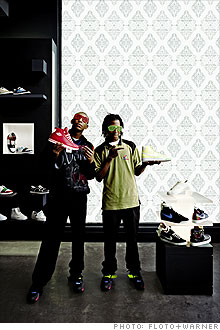A hidden shoe gallery for elite buyers
A St. Louis shoe emporium boosts sales by going undercover.
 |
| Sneakerheads: Customers amid RSole's fancy footwear. |
 |
| RSole's design is more akin to a gallery than a typical retail space. |
(Fortune Small Business) -- It's easy to walk past RSole, an up-scale shoe boutique in University City, Mo., and completely miss it. The storefront, which sits on a busy street near Washington University in St. Louis, consists of a wall of frosted glass. The door is almost invisible. Products are displayed in a smattering of square peepholes.
"It's not unusual for people to call the store because they can't find it," says owner Barry Pener, 49. Surprisingly, that's just what he hoped for when he had the idea for the shop.
Before he opened the first RSole in May 2006, Pener ran Man of Fashion, a 35-store chain founded by his grandfather. Now Man of Fashion is a division of Pener's umbrella company, D.B. Pener, and targets the urban market with a range of casual clothing and sneakers.
About four years ago, Pener began seeing a new type of customer. "Sneakerheads started coming in just to look at the fanciest shoes," he recalls. "They were treating the footwear like pieces of art."
Pener's sales contact at Nike (NKE, Fortune 500) advised him to study an emerging trend: high-end sneaker stores located mainly in Los Angeles and New York City. The stores' customers, typically 18- to 34-year-old men, spend anywhere from $80 to more than $500 a pair on footwear made by companies such as Nike, Puma and Adidas. They often buy several pairs of shoes a year and wear them infrequently, if ever. Nike's sales rep suggested that it was time to open a similar boutique in the Midwest. So Pener flew to New York City to scope out retail designs. While he was there, a SoHo clothing store called Michael K. caught his eye. Pener contacted the firm that designed it, Tobin + Parnes.
Pener told Carol Tobin, principal of the 15-employee design and architecture firm, that he wanted to distinguish his new store from Man of Fashion. RSole would carry some of the same shoes, but Pener wanted to showcase them in a swankier setting.
But how to make a sneaker store look exclusive? Tobin's inspiration came during a walk near her offices in lower Manhattan. She noticed a line forming on the sidewalk. Unable to see where it led, she made inquiries and learned that a crowd of shoe fanatics had waited all night for a sneaker debut. Tobin had missed the shoe store because it bore no sign. "I later heard the shoe sold out overnight," she says.
When Tobin met again with Pener, she pitched the idea of a space with an anonymous storefront. He instantly fell in love with the concept, which used a nonsell sales strategy - a retail tactic based on the counterintuitive theory that obscurity draws elite shoppers.
Tobin made the interior black to establish a gallerylike space that would treat the shoes as works of art and reinforce their status as collector's items. "Black sucks up light, so we had to focus light intelligently," Tobin says. "We installed fixtures at indirect angles in the walls and on the ceiling to add drama and draw attention to the shoes."
The designer embedded LED squares in the floor to define merchandise areas and create an active visual environment. Staff can control the color and intensity of the light. "The LED squares direct people along certain paths, like emergency lighting," says Tobin.
Such deliberate anonymity flouts conventional retail wisdom, but Pener wanted to encourage passersby to walk up to the storefront and peer through the peepholes. At first, that didn't happen.
"We opened, and I was really nervous," Pener recalls. "People were just walking by." According to Pener, it took about three months for customers to discover the store after it opened in May 2006. By then RSole was beginning to build word-of-mouth buzz, and foot traffic steadily increased.
The boutique started to draw the clientele Pener had targeted: the sneakerheads. Pener says his sneaker-crazy customers "claim the store as their own and want to be associated with it." Celebrities, including Ted Ginn Jr. of the Miami Dolphins and local hip-hop star Murphy Lee, also shop at RSole.
RSole generates only about 5% of D.B. Pener's total revenues, but Pener says the new brand, which added a second location in Memphis in 2007, sells more than 2,000 pairs of sneakers a month, producing more sales per square foot than Man of Fashion.
While the sneakerheads drop hundreds of dollars on the latest shoes, they're also buying the store's design, Pener notes. Approximately 40% of RSole's inventory is also sold at Man of Fashion and other bigger retailers. "Customers could just as easily go to my other stores," he says. "But they'd rather shop here."
Hiring Tobin + Parnes was expensive - the design fee for the first store alone was about $120,000 - but Pener says that choice was crucial to RSole's success, and he hopes to work with the firm to open five additional stores by 2010 or 2011. Pener says RSole owes its success to its design. "Without that, it would have been just another shoe store." ![]()
-
The Cheesecake Factory created smaller portions to survive the downturn. Play
-
A breeder of award-winning marijuana seeds is following the money and heading to the U.S. More
-
Most small businesses die within five years, but Amish businesses have a survival rate north of 90%. More
-
The 10 most popular franchise brands over the past decade -- and their failure rates. More
-
These firms are the last left in America making iconic products now in their twilight. More








